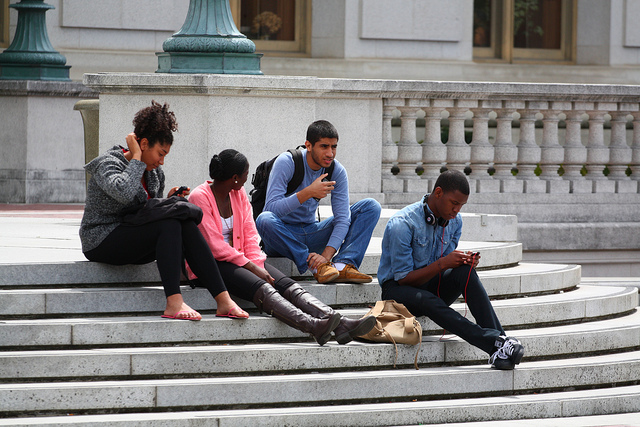 cc licensed ( BY ) flickr photo shared by Cikgu Brian
cc licensed ( BY ) flickr photo shared by Cikgu Brian
Last October I posted some criticisms of moocs (massive, open, online courses) in humanities as too massive to really deal well with promoting critical skills in learners. Recent experience has made me change my mind, but it’s going to take two blog posts to explain. This is the first. (The second is here.)
Part of the issue with MOOCs that I expressed in my earlier post was that they were too content-focused, and seemed most conducive to topics in which that content can be machine-assessed (with multiple-choice or other automate-able question/answer formats). I wondered whether critical thinking, reading, writing and discussing skills could really be done well in a MOOC.
The problem is, at the time I wrote that I fell into the common trap of thinking that MOOCs are a monolithic type of entity. I may, perhaps, be forgiven this as most of the press about MOOCs is about the Coursera/EdX/Udacity type (as Alan Levine notes in a blog post–see below). It was only through participating in etmooc, a mooc about educational technology and media, that I found that there are other options.
Not all MOOCs are equal
One way of distinguishing types of MOOCs (at least at the moment…things are always changing) is to break them down into two categories: xMOOC and cMOOC. What do these categories mean? The “c” in cMOOC stands for “connectivist,” but I am not sure what the “x” in xMOOC stands for. [Update May 27, 2013: This Google+ post by Stephen Downes says he started calling them xMOOCs because of the “x” used in things like EdX–which stands for the course being an extension of regular university course offerings].
See here, here and here for some explanations of the differences between cMOOCs and xMOOCs. [update March 17, 2013:] Here’s an even more detailed discussion of the differences, by George Siemens. Lisa M. Lane has come up with three categories for MOOCs, though I’m not familiar enough with the “task-based” MOOCs to really comment on them.
Alan Levine has a thought-provoking blog post on the numerous experiments in open learning (should we call them MOOCs?) that are going on at the moment, and how they are very different from the xMOOC model. The range of possibilities in courses that are open to anyone and everyone is astounding.
The etmooc course I’ve been participating in since Jan. 2013 is in the cMOOC category (or, in Lane’s three categories, it’s a “network-based” mooc). The “connectivist” aspect of it is obvious, as it seems clear that one of the main points of the course is to help people forge connections in order to learn from each other. There is a set of topics, one every two weeks, with presentations by various people working in those fields (all archived here). But the emphasis is not at all on learning content. Rather, participants are encouraged to watch the presentations they are interested in, and then (and mostly) to interact with the rest of the community in various ways: through twitter (#etmooc), a Google+ community, a community-curated list of links on Diigo, and posting and commenting on blogs (syndicated in an etmooc blog hub, though many of us read them on an RSS reader). We also have a weekly twitter chat (#etmchat) in which we discuss issues related to the topic for the week.
There really is no single “place” where the course is; it exists in the discussions we have with each other, the blog posts and digital stories we create and share, the connections we make with others and the conversations (about etmooc and teaching/learning generally, and other things) that we have. I haven’t watched all the presentations, and don’t plan to. Nor is it encouraged. Over and over we are reminded by the course “conspirators” and other participants that etmooc is driven by our own interests (and our own schedules…some have more time than others), and that there is no such thing as being “behind” in etmooc. You dive in when and where you want, and the most important part is to engage in discussion when you can. Blog, comment on others’ blogs, participate in Twitter and G+, or whichever of those you feel you can do.
Among other things, the “about” page for the course says:
Sharing and network participation are essential for the success of all learners in #etmooc. Thus, we’ll be needing you to share your knowledge, to support and encourage others, and to participate in meaningful conversations.
Without the various conversations going on in and around etmooc, there really wouldn’t be a course at all. It exists in our connections and discussion, in the things we share and the comments we make.
In addition to forging connections, etmooc, and other cMOOCs from what I understand, are focused on content creation rather than passive learning of content. In etmooc we contribute to content creation by writing in our own blogs and commenting on those of others. Recently we did a segment on digital storytelling and we created numerous digital stories (see my blog post here for links to a few examples). Right now we are talking about digital literacy and are invited to participate in Mozilla’s work to develop a framework for web literacy (open to anyone to contribute).
Etmooc also requires self-directed learning–participants must choose what to focus on, what to read, what to write about, whether to keep up on twitter and G+ or not, etc. There is no set of course objectives that are decided in advance, as explained in this conversation about learning objectives and cMOOCs on Storify. Rather, as Alec Couros puts it in that Storify conversation, participants are to develop their own learning objectives. Different people will engage with the course for different reasons, pursue different paths. And that’s the point.
The value of a cMOOC
Does it work? Do people learn? All I have at the moment is anecdotal evidence.
I have learned more in the last few weeks in etmooc than I ever did in any other professional development opportunity. It’s because of the connections and discussions: I read others’ blog posts (only a few a week, really; don’t have time for more), comment, and get conversations going. And the same thing happens now on my blog. My twitter lists have expanded widely, and I am getting so many links to articles, blog posts and other resources that are useful for topics I’m interested in.
I agree with Michelle Franz, though I’d say it’s not just twitter I’m learning from in etmooc:
See also Paul Signorelli’s mid-term reflections on etmooc, where he gives this list of what he has done and learned so far (among other things):
I have become an active part of a newly formed, dynamic, worldwide community of learners; continue to have direct contact with some of the prime movers in the development of MOOCs; had several transformative learning experiences that will serve me well as a trainer-teacher-learner involved in onsite and online learning; and have learned, experientially, how to use several online tools I hadn’t explored four weeks ago.
MOOCs and feedback, interaction
Ted Curran notes in a recent article (found via @jackiegerstein) that MOOCs–or rather, xMOOCs–are “the internet-scale version” of huge introductory courses at large universities with hundreds of students: “massive, impersonal, and uninspiring exercises.” He notes that this model works well if you want to save money (more students, fewer faculty), but it doesn’t work very well pedagogically. What is needed for both the online and in-person teaching and learning platforms, according to Curran, is more emphasis on faculty interaction with students: “personalized timely feedback and frequent interaction with the teacher is more important to student success than the quality of lecturer, the quality of the textbooks, or the use of technology in courses” (emphasis in original). What MOOCs, and online learning in general, can do is to allow faculty
to automate the less effective activities (lecturing, exams, grading) so they can spend more time interacting with students (discussions, online office hours, targeted interventions when students fail assignments.) In short, online teaching tools let teachers spend more time on students and less time regurgitating content.
I agree that faculty/student interaction in courses can be important; it’s one of the most-cited things that students in Arts One said in a recent survey that they valued about the course. But realistically, is this possible in a MOOC that has thousands of participants? How many faculty can actually interact in a meaningful way with students in a course whose enrollment is upwards of 10,000 students or more?
Enter the cMOOC.
Must the interaction that is necessary to student success come from the instructor? Why not set up and foster a space in which interaction is encouraged amongst participants–indeed, where interaction and discussion are as much of (or more of) the focus as content delivery?
I don’t think the discussion boards on most or all xMOOC courses are enough. Discussion boards are limited as a technology: for example, I think blogs are better for posting lengthy reflections, including links and photos/videos, etc. Following blogs and Twitter feeds also promotes more lasting connections to foster learning after the course is finished. Encouraging participants to blog, comment on blogs, and interact in other ways such as Twitter and Google+ (or similar) has, in my experience with etmooc, worked very well.
The experience is still huge–there are far too many blog posts, tweets, G+ posts to follow. But the conspirators and participants are constantly reminding each other that keeping up with it all is not the point. Again, diving in where and when you want is. That, and creating smaller groups organically, through creating connections–deciding which blogs and twitter accounts to follow regularly, for example. Or creating your own smaller group within the larger group, with its own wiki, as another example.
In etmooc the “conspirators” tweet regularly, join in on some discussions in G+, comment on a few blogs here and there, but they don’t even try to interact with everyone. Instead, they have managed to create a space where participants engage mostly with each other.
Now, a purely connectivist mooc won’t work for all purposes; I’m not arguing for replacing xMOOCs with cMOOCs entirely. After all, in some disciplines there is a certain amount of content that simply must be grasped before one can really engage in meaningful discussions with others about the field. Further, for participants to thrive in a cMOOC, they have to be self-directed learners, as noted above, and not everyone is comfortable with this sort of learning.
But why couldn’t xMOOCs take some ideas from the successes of cMOOCs and incorporate more connectivist principles and practices alongside the traditional methods of learning they tend to use?
MOOCs and the media
Alan Levine points out, in the post linked above, that in mainstream media outlets you won’t hear about many of the “experiments in open courses” that some cMOOCs could be called (including etmooc). While drafting the first part of this post I was also engaging in a Twitter conversation with Rolin Moe (@RMoeJo) about how the hype about MOOCs in the media focuses on one type of MOOC only, even though there are at least two. As he noted, the “connectivist” MOOCs tend to be popular amongst educators, academics, and a few others, and they aren’t winning the PR battle.
The other problem, as we discussed in our twitter conversation, is that cMOOCs are often run by volunteers, because they believe in open learning, and there isn’t much in the way of trying to monetize the efforts. That doesn’t make for interesting news, apparently.
A different name?
Since mainstream media has hijacked “MOOC” to mean xMOOC, perhaps it’s time to call the cMOOC something else? Which is ironic, since apparently the whole idea of MOOCs started with cMOOCs (see “connectivist MOOCs” here).
Nevertheless, would a new name help to avoid the confusion? Or is it enough to try to push the xMOOC vs cMOOC distinction?
*** Update March 14, 2013 *****
I just found this blog post by David Kernohan that points to a third option: open boundary courses, in which an on-campus course is opened to outside participants (usually not for credit). It seems to me the “open boundary” courses could be either more like cMOOCs or more like xMOOCs in structure.




